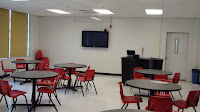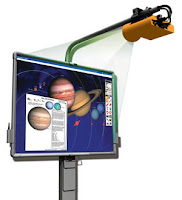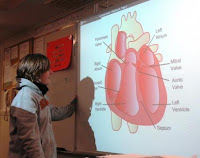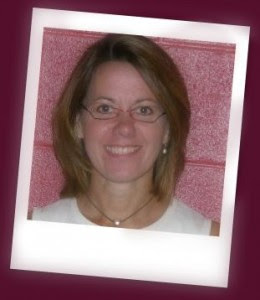About Me

- Joyce
- I am a stay at home mom of two boys. I am taking this class to keep my certification.
Tuesday, April 21, 2009
My EDM 310 Blog Assignments are Now COMPLETE.
ACCESS visit





Did I learn?
Week 15 post
Monday, April 20, 2009
Week 14 post-Pluses and Minuses of Blogging
Monday, April 13, 2009
Week 13- EDM310 podcasts
Monday, April 6, 2009
Week 12 Post
The second podcast focused on what type of questions teachers ask their students. The questions that guide learning and focuses the learning of the students. Using technology helps the students explore, investigate, "play with", and ask why? The questions that are generated guide the students to think and reason, and in return they remember better what they are learning. A traditional math class is lesson by lesson and chapter by chapter. Some students are not able to learn this way and become frustrated and become dis-engaged. Other students memorize useless information and do well on the test, but soon forget what they memorized. By engaging them with the latest technology (visual models, differentiated instruction, real world applications) the teacher creates a different way of learning.
As a former teacher I remember how frustrated our technology coordinator would get when "those" teachers refused to attend any workshop that had anything to do with new technology. "Those" teachers used the computer for making tests and checking e-mail and that was enough for them. I was the opposite. I was eager to use whatever I could in my classroom to enhance my students learning. And by doing this I saw first hand what a difference it made in student participation, pride, and grades. I have a son who is 6 and can use a laptop better than I can. Technology is here to stay and will only get more popular. Teachers should feel an obligation to be "up to snuff" on the latest and be able to incorporate it into their lessons.
Tuesday, March 31, 2009
Electronic Contact Assignment

For this assignment I contacted Stacy Pugh, a Biology teacher at Vestavia Hills High School in Vestavia Hills, Alabama. I taught in the Birmingham area for 6 years and know of the reputation of this school system. The Vestavia school system takes pride in being on the cutting edge of technology and engaging instruction. Mrs. Pugh was very prompt in replying to my e-mail and was very eager to help. The first question I asked her was about the greatest and latest technology that she is using in her classroom. She was very helpful and she sounded very excited about the technology that she uses. According to Mrs. Pugh, Vestavia Hills has some of the most advanced educational technology tools available at this time. The Board of Education in this system just spent several million dollars outfitting each and every classroom with Promethean boards (pictured on the right) and the software to support them. Each teacher attended a two day mandatory training class. Mrs. Pugh referred to this class as a "crash course". Each teacher learned how to connect, turn on, and operate the actual hardware. She expressed her disappointment in the fact that the teachers did not have any time allowed to brainstorm with her peers and formulate ways to use the technology.


Sunday, March 29, 2009
Week 11 Stanford Podcast
Professor Dweck also is working in conjunction with a race car driver on her topic of mind growth. The race car driver read her book and wants her to help him grow his mind with his racing. She believes that she can help the race car driver to have a growth mind set in order to learn from his mistakes and become a better race car driver.
I know this professor has written a book and done major research, but what she is saying is not anything new or profound. Teachers have been dealing with these types of students for a very long time. In a class room a teacher is going to have the students who try to appear smart, who are smart, and who try really hard to be smart. I know that as a professional I am not suppose to have favorites, but my favorite student is the one who gives 110% every day. They do not have to be the most intelligent, or make the best grades. They just have to be a hard worker. Watching this podcast has solidified the fact that we should not only expect our students to learn from their mistakes, but we, as teachers, should learn from ours. We should be able to admit to our students when we mess up. This would be leading them by example. They would be able to see that it is ok to mess up and that teachers are still in the learning process too. Teachers also need to be very mindful of the students who are trying to grow their minds, and try to encourage these children to take get out of the comfort zone of learning. Learn things that are not fun or interesting. STRETCH those Neurons!!!! I have taken many classes (most all of my graduate school classes) that made my head hurt and that I hated, but I didn't give up. And I came out on the other side with a great degree and even better than that a confidence in myself that I would have missed out on. This is what we should want for our students.
Sunday, March 22, 2009
Week 10- WGBH video podcast
For this weeks assignment I viewed 5 video podcasts. I am a science teacher, therefore, I checked out all the science categories. The subject of science was divided into the following groups: Life science, Earth and Space science, Physical science, and Engineering.
Earth and Space Video Podcasts:
The first video podcast that I watched was in the Earth and Space Science section and it was about solar eclipses. I remember teaching about solar eclipses and drawing all the diagrams on the board and doing demos using tennis balls. I wish I would have had access to this short little video clip. It used great diagrams, great examples, great visuals, and it covered the vocabulary associated with a solar eclipse. The video was only 3 minutes long and that its perfect to me because it would be the perfect size to reinforce what was covered in lecture and would help solidify terms and the movement involved during an eclipse. I also watched Earth as a system, observing clouds, and characteristics of the sun. The podcast about the earth was narated by James Earl Jones and I thought that made it interesting because you were listening to a famous person ( and who doesn't like to listen to Darth Vadar talk?), This podcast was more like a documentary and a little more lengthy, but it would still be very useful. The podcast about the sun had all the basic information students need to know about the sun and it put things in a perspective that the students could understand. The terms and definitions were present and easily understood. The observing clouds podcast was very simple. You sit and watch clouds float by and watch them move and change. This podcast would be great for elementary aged students or as a fun introduction to clouds for upper level students.
Life Science Video Podcast:
I watched one video in this section about the frozen frog. It was very interesting and could be used to explain several things. Camouflage was mentioned several times. A teacher could use this frog to start discussions of the topic survival of the fittest, or could use this video to get students thinking or should I say hypothesizing about why the frog freezes and what it accomplishes. Students would love this video because it has green slimy frogs and they freeze and then thaw out and hop away.
I am very excited to use this resource in the classroom. Looking back on my past teaching experience I wish I would have had these then. I can see the possibilities and learning opportunities these podcasts provide. To reach these podcasts you go to iTunes store, then click on iTunesU, then click on featured educational providers, and then click on WGBH.
Sunday, March 8, 2009
Week 8- Fall 08 Podcasts
The positives about the first podcast were that the guy had a nice slow clear voice. He was very easy to understand and I was able to follow him easily. Both podcasters knew what they were talking about, but at the same time both became confused half way through their talking points. The negatives about the first podcast were they both seemed to get confused, they both jumped around a bit on the topics, and the flow of the conversation was choppy. Their different points did not flow together. I became a little confused about some of the things they talked about.
The positives about the second podcast were that this team had fun with each other. They teased one another and that made it fun to listen to. The 2 ladies sounded professional and knew what they were talking about. The young man was a bit rude and insensitive. He did not seem to have put alot of work into this assignment. I could only find one negative thing about this podcast (besides the young man) and that was their thought could have been a little more organized and they could have had specific points they wanted to talk about.
Tuesday, February 24, 2009
Podcast Post
The first thing I noticed about all 4 recommended podcasts was that each one had music as the introduction. Not one of these podcasts started with talking. I like the way the music gave me a chance to get focused and ready for the podcast. Another thing I noticed about each podcast was that they all had sponsors and the podcast subscriptions were free. This means that the sponsors pay for these podcasts and the consumer does not have to. All of these podcasts had hosts that were enthusiastic, easy to listen to, and kept it going. The SmartBoard Lesson podcast consisted of a man and woman, and they discussed using the SmartBoard as a teaching tool. There podcast is almost a weekly occurrence. KidCast has one host and this podcast focuses on using the podcast in the classroom. The podcast happens once every few month. This one did not hold my attention like the first podcast mentioned. It seems better to have more than one person on a podcast to keep it more interesting. The discussion and feedback from others is important. MacBreakWeekly is a weekly podcast and was the most entertaining (even though it was Mac related). There were 3 or 4 hosts and they made the podcast have a more radio show like feel to it. They shared personal information and laughed with one another. This podcast had the most sponsors. It took the main host quite a while to list all of them. TWIP podcast was similar to the MacBreak Weekly. It had the same format and same sort of atmosphere.
Listening to just these 4 podcasts helped me realize 3 things about podcasting in general. Number one: Intro and background music gives the podcast a more professional vibe. Number 2: Having more than one host gives the podcast more life and dimension. Number 3: The host needs to have enthusiasm and fun.
The next 3 podcasts I listened to were Story Nory, Why? The Science Show for Kids, and Motion, Forces, & Energy. Story Nory is a podcast that brings a new story to children every week. The narrator has a lovely voice and is very easy to understand. This podcast would be a great resource for elementary school teachers. I could see a teacher using this podcast during rest time. Allowing kindergartners to listen as they lay on their mats would be a novel way to do nap time. Teachers could let children listen to the story and then draw a picture of what they heard (this would help them with their comprehension). There are so many options for a teacher if they used this podcast. Why? The Science Show for Kids podcast is hosted by a scientist who answers kids questions every week. Of course he can not answer all the questions that are submitted but he does a nice job of having a wide variety of questions and answers. I could see myself using this concept to creating student podcasts and the assignment would be to answer certain questions, work as teams to answer the questions, submit questions about the current material being studied so I could better explain it using a podcast. Again, I can see the podcast being used for so many things in a science classroom. The last podcast was very basic but I really like it. It was a teacher's podcast and he reviewed the different sections in a chapter. He would refer to the text, and then elaborate on the concept. This is a great teaching tool. Once students get home and begin to do their homework they may think,"Now what did he say about..." And all they have to do is go to his podcast and they can hear him say it. I like the way he uses the podcast, and I would like to use it to record my "Note Time" in class. That way if a student is absent they can go to my podcast and hear what we talked about in class. The options for using a podcast in the class room are almost endless. Yeah podcast! To hear any of the 3 podcasts listed above all you have to do is go to Search iTunes Store and type in the name of the podcast.
Monday, February 23, 2009
Last Lecture Post
Randy mentions in his lecture that teachers need to focus on the fundamentals, and that we need to get these down pat before we get fancy. I agree with this statement 100%. When I taught 7th grade science I spent more time on fundamentals because it is the foundation from which my students were going to build. If the foundation is shaky, there is a good chance that the structure will fail. When a student masters the fundamentals there will be a confidence that becomes present in that child's school attitude. Teacher's play such a huge role in planting the seed of confidence in a child. And as that child grows in education that seed will grow into a plant and one day will produce fruit of its own. Student/teacher bonds will form when a teacher goes the extra mile to help a struggling student. These bonds are crucial to the student. The student begins to see that the teacher cares and can be trusted. The bond that forms leads me to my next teaching/life skill: respect.
On the first day of every new school year I would start with "The Talk". I wouldn't start of with the rules or with my expectations. I would start of on a personal level. I taught 12 and 13 year olds and I can remember what it was like to be that age. Everyone, no mater what age, wants to be respected. But I feel that at this age it is more needed then ever. I would let them know that even though I didn't know them, I respected them, and it was up to them to keep that respect. If I give my respect I expect respect in return. If respect was shown respect was given. Randy mentions loyalty in his lecture. He gave the example of the student having problems with the dean and he went and stood up for the student. Because he was willing to stand up for that student, that student is now standing up and taking the lead for Randy. It is because they respected and believed in one another. I spoke with me students in a tone as if I were talking to friends. I assured them that I would always treat them as people, not as children, but as individuals with ideas, opinions, and thoughts.
I loved Randy's enthusiasm. I couldn't help but keep listening to what he had to say. When a person believes 100% what they are saying then that enthusiasm pours out of them. In teaching my students picked up on my level of enthusiasm. I set the tone for learning each and every day. If I did not buy into an activity, then I could not expect them to. Most days I was excited about what we were doing in class and I tried to make each learning activity have a certain level of fun in it. Making learning fun and engaging was the most challenging aspects of being a teacher. I had to work hard at it, but it always paid off when I say the excitement on my students faces or when students walked in the room telling me they couldn't wait to come to science class.
I saved brick walls for the last topic. I hate brick walls. I have never thought about them the way Randy talked about them in his lecture. He said that brick walls are not there to stop us, but to get us to prove what we can really do. We have to persevere. We have to keep working until we make it to the finish line. We have brick walls in every area of our lives (school, home, work, family, friends, grocery store, etc). He also spoke of being self-reflective and I think that when I hit a brick wall that is what I do. I reflect on what happened and then work on a solution and work hard to get over the wall or how to knock it down. Teachers can give students the necessary skills to be able to identify those brick walls and help them get over that wall. No child is going to be great at every subject. That is where the teacher comes in to make the difference.
Saturday, February 7, 2009
Week 5 Post
 Both of my international teacher's blogs were found on the website edublog. This site is available for teachers and students. It serves over 275,000 bloggers at this time. It is a free service and has easy steps to follow on how to create a blog. This site offers what seems to be the blogging equivelant of some of the aspects of ACCESS, but on a national and international scale.
Both of my international teacher's blogs were found on the website edublog. This site is available for teachers and students. It serves over 275,000 bloggers at this time. It is a free service and has easy steps to follow on how to create a blog. This site offers what seems to be the blogging equivelant of some of the aspects of ACCESS, but on a national and international scale. 

Thursday, February 5, 2009
Week 4 Post
 Mrs. Reagan (pictured on the left) is the principal of Georgetown Elementary School.
Mrs. Reagan (pictured on the left) is the principal of Georgetown Elementary School. Georgetown Elementary school in Michigan has a school blog that is very similar to a website but has so many more capabilities. A person can find any information on this blog. Every teacher in the school has a class blog and the links to that blog are on the schools blog. You can view the school calendar by week or month and view an agenda for the days selected. This school blog has comments from schools in Taiwan. This blog show immediate connections to schools all over the world. There is a section called Live Action Feed and it shows the locations people who have visited the blog. Foley, Alabama popped up in this section because I have been looking at this schools blog. I am very impressed and excited about the capabilities of blogs.
Sunday, February 1, 2009
Week 3-Post #2
Saturday, January 31, 2009
ACCESS post
Friday, January 23, 2009
Plagiarism
Tuesday, January 20, 2009
ALEX
This website seems to be a first year teachers best friend. The hardest part of teaching for the first time is knowing where to begin. ALEX is a great starting point and will give a new teacher a specific direction. The site is very well organized and is easily navigated. In addition to being useful, this site will help teachers manage their time. Since course of study, lesson plans, we blinks, and workspace are all located in one place a teacher will be able to work more efficiently. Time will definitely be saved and the teacher will be able to focus on the quality of her students' education.
Thursday, January 15, 2009
Post #2 for week 1
Tuesday, January 13, 2009
Who's That Girl?
My name is Joyce La Force Fisk. I am married to Sean Fisk and we live in Bon Secour. I am a stay at home mom and have two boys (Christian-5 and Ethan-2). I am taking this class in order to keep my certification current. I am a certified secondary science teacher. I received my BS in Secondary Education/General Science from USA and my Masters of Science in Geosciences from MSU. My teaching experience is limited to a single school system. I taught seventh grade science for 6 years in one of the best school systems in Alabama and I have been home with my boys for the past 4 years. I am planning to go back to teaching in the next 5 years.
In my spare time I like to scrapbook. It is a good creative outlet for me, and I am being productive. I also enjoy TaeKwonDo. I have been a student of this martial art since January 2008. I am a senior blue belt (half way to black belt) and plan to be a black belt by the end of this year.
